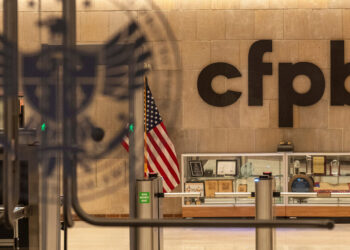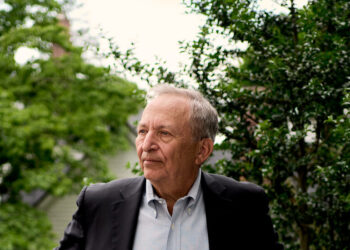The jurors in the case of The United States of America v. The Sandwich Guy (as Sean Charles Dunn is better known) sized one another up before the final group had even been selected, asking, “Did you attend the ‘No Kings’ march?”
“It’s like, You’re damn right I went,” one juror told me, referring to the anti-Trump protests throughout the country last month, including in Washington, D.C. (The juror, who spoke with me several days after she and 11 of her peers found Dunn not guilty of assault, did so anonymously because, as she explained, Donald Trump’s administration is “very vengeful,” and she fears retribution.)
The facts of the incident are ostensibly simple: In the early days of Trump’s militarization of the nation’s capital, Dunn—a 37-year-old Air Force veteran and, at the time, Justice Department employee—screamed at federal officers stationed in a popular nightlife corridor, repeatedly calling them fascists, and then hurled a Subway footlong at a Customs and Border Protection agent, hitting him squarely in the chest. “I did it. I threw a sandwich,” Dunn confessed to law enforcement upon being apprehended—a sort of modern Williams Carlos Williams (“I have eaten the plums that were in the icebox…”) for the more carnivorous, angrier set. Although it was widely reported at the time that the sandwich was salami, Dunn later said it was turkey.
Four days later, despite Dunn offering to surrender to the police, at least half a dozen law-enforcement officials in tactical gear staged a nighttime raid on his apartment, bringing him out in handcuffs—footage of which the White House blasted out in a highly stylized video, reminiscent of a Netflix FBI thriller. Finally, after a federal grand jury failed to indict him on a felony charge, prosecutors attempted to get him on misdemeanor assault.
Like nearly everything involving Trump, the episode became polarizing, absurdist, stripped of nuance—a Rorschach test for both one’s politics and one’s life experience. (As someone who in my early 30s lived just off the nightlife corridor near 14th and U Streets where the hoagie histrionics occurred, I initially assumed: Drunk dude, egged on by drunk people, does drunk thing.)
[Read: Why is the National Guard in D.C.? Even they don’t know.]
And so, in an escapade to which everyone brought a deeply personal perspective—the government that dubbed Dunn an “example of the Deep State”; the D.C. residents who turned him into a Resistance folk hero memorialized in street art and Halloween costumes; the sandwich thrower himself, whose lawyers portrayed him as unfairly targeted by the Trump administration—the 12 jurors found themselves simply trying to do their jobs, as fairly and impartially as possible.
The juror I spoke with told me that the jury—three men and nine women (roughly an equal mix of Black and white)—included an architect, a professor, an analyst, and some retirees whom she described as probably “100 percent anti-Trump” and protective of their city. She went into the trial thinking it was “bullshit,” she told me, “but I did enter it trying to be objective.”
She knew from the start that any verdict could be weaponized: A guilty verdict would be a victory for the Trump administration as it tries to stifle criticism of federal overreach in D.C. But a not-guilty verdict could signal that it’s okay to attack federal agents who are trying to do their jobs (or, more picayune, that urban sandwich flinging is an acceptable pastime).
The group was careful to avoid politics, she said, and instead focused on several key questions: Had the sandwich actually “exploded all over” CBP agent Gregory Lairmore, as he’d testified? (Specifically, they analyzed—and at times mocked—Lairmore’s claim that “I had mustard and condiments on my uniform, and an onion hanging from my radio antenna that night.”) What was Dunn’s intent in flinging the grinder? And what actually constitutes “bodily harm”?
On the first question, several jury members struggled to stifle laughter as Lairmore expanded on the hoagie’s alleged explosive properties. “It was like, Oh, you poor baby,” the juror told me. But the group observed that photos of the sandwich at the scene showed it fully intact, still in its Subway wrapper. “So how did it explode?” the juror wondered. She said they also discussed the fact that law enforcement had not retrieved or bagged the sandwich as evidence, the way they would have done with an actual weapon, like a gun.
The jurors also debated Dunn’s motivation in transforming his turkey sub into a projectile. Was he just an overgrown toddler, having a tantrum? Would it have been different, they wondered, had he flung a rock, rather than deli meat on a soft baguette? Was this free speech or assault? Did it matter if his goal was to protect a vulnerable community?
Dunn’s lawyers presented a version of this explanation in court: Dunn said he had seen the officers standing outside a gay club, Bunker, that was hosting a “Latin Night.” He worried they were about to stage an immigration raid, so he got in their faces, calling them “racists” and “fascists” and repeatedly bellowing: “SHAME! SHAME!” His goal had been to draw them away from the club. (“I succeeded,” Dunn said, referring to the officers who left their perch in front of the club to swarm him as he ran away.) And the defense had likened Dunn’s act to a harmless “punctuation,” an “exclamation mark at the end of a verbal outburst”—an argument the juror told me that several of her peers found resonant.
But the biggest sticking point was whether Dunn had caused bodily harm. At one point, the jury sent a note, asking how “injury” is different from “bodily harm.” “The definition of injury isn’t just bodily harm—it’s offensive touch—and we struggled with that because we all said we’d be offended if a sandwich hit us, but then this agent was standing with about 14 other agents on the corner of 14th and U, all kitted out,” the juror told me.
[Read: Trump’s dreams for D.C. could soon hit reality]
Especially compelling, she added, was the defense’s argument that Lairmore himself did not seem to have ever felt truly threatened, pointing to several gag gifts—a plush toy sandwich, a Felony Footlong insignia—from his co-workers that he displayed proudly. Her sense that Lairmore didn’t find the incident offensive, the juror explained, “was really a slam dunk.”
In her mind, she told me, the prosecution’s strongest argument was, essentially, that civilized people don’t throw sandwiches. “We teach our kids not to throw things when we’re angry,” she said. “We all struggled with that because he admitted he threw that sandwich. It was not respectful or smart to throw the sandwich.”
The juror told me that she personally did not know much about the case before being selected—just that it had initially been dismissed as a felony, and that “the sandwich man was kind of an icon around town.” But she said she “totally wanted to serve” because she thought it posed an interesting legal question: “Not a felony but a misdemeanor?”
Interesting legal questions aside, the trial took on a dadaist sheen, befitting the act itself. The juror told me that she and her fellow jurors used words like absurd, laughable, and waste of government money. “We’re supposed to be looking at the evidence, but a clear majority felt it was nonsensical, like Don’t waste our time or money,” she said.
At one point, sandwiches were served for lunch, an irony not lost on a jury spending hours contemplating the many possible uses of the breaded form (nutrition, satiety, projectile). “Then we had lots and lots of jokes about the condiments,” the juror told me, noting that lunch was, however, not subs but “more traditional sandwiches, sadly” (chicken salad, tuna salad, ham, and turkey, specifically).
At another point, two jurors happened to be wearing pink—the same color of Dunn’s shirt the night in question—and someone suggested everyone wear pink the next day, or perhaps “D.C. Statehood” shirts, in a small act of resistance. (The motion was rejected.)
Ultimately, the juror said the group decided the case on its merits, deliberating for seven hours over two days, before declaring Dunn not guilty. “We probably could have gotten the thing resolved on the first day, but there were two holdouts, and we really didn’t want to steamroll them,” she said. “We wanted them to come to the conclusions on their own and see if they could be convinced to switch their position based on the facts and evidence.”
Still, the juror I spoke with said that as she learned more about the case, she had come to view Dunn with complicated admiration. “If he was trying to lure law enforcement away from innocent people, I think he’s a hero. He was trying to do the right thing, and he was getting very, very angry and frustrated, and I think a lot of people can relate to that,” she said. “He’s an unlikely hero, maybe, but he stood up for his beliefs, and I respect that.”
At a news conference last week following his acquittal, Dunn appeared outside the courtroom in a suit, looking thinner than he had in the August sandwich throwing video. (The juror told me that she thought he looked “like a stick insect,” surmising he’d lost weight from the stress of the ordeal, and also agreed “100 percent” with my observation that whereas the artistic depictions had transformed Dunn into a Banksy-style vigilante—black clad, hat backwards, arm cocked—in real life he looks … far more nerdy.)
After thanking his legal team, Dunn said he had acted to protect the “rights of immigrants,” and quoted the unofficial Latin motto of the United States: e pluribus unum. “That means ‘From many, one.’ Every life matters, no matter where you came from, no matter how you got here, no matter how you identify. You have the right to live a life that is free,” he said, before turning away from the assembled media.
“Sean, what does that have to do with throwing a sandwich?” a reporter called after him, not unreasonably.
Yet the question missed the point. From almost the moment the sandwich left his hand—before it either did or did not explode on a border agent’s bulletproof vest—the incident had transcended the act of simply hurling a hoagie.
The juror’s decision to speak with me anonymously felt rooted in the current moment, informed by her views about this administration, and its penchant for retribution, as much as Dunn’s act was informed by his view of the threat that gay people and immigrants face in this new Trump era. After all, if you fear your country is slipping toward authoritarianism, isn’t sacrificing your late-night Subway snack the least you should do?
“Even the fact that I am reluctant to give you my name—in any other situation, I probably wouldn’t mind, but I feel like somebody might come after me,” the juror told me. “Would I have felt that way in the Biden administration or the George W. Bush administration? No way.”
Marie-Rose Sheinerman contributed to this report.
The post Inside the Sandwich Guy’s Jury appeared first on The Atlantic.




